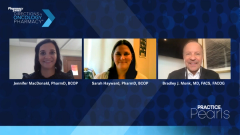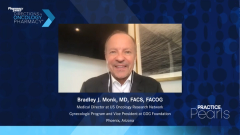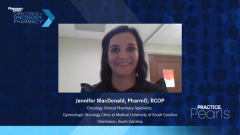
Practice Pearl 3: Reducing Costs of PARPi for Ovarian Cancer Treatment
Experts in gynecologic oncology provide insight on available patient assistance programs to help lower costs of PARP inhibitors for the treatment of ovarian cancer, and how pharmacists can aid in obtaining this information.
Episodes in this series

Jennifer MacDonald, PharmD, BCOP: The last thing that we wanted to conclude with is something that we talked about. Sarah, can you touch on how you help get patients in assistance programs for any of these therapies in the era of trying to be cost-effective? NCCN [National Comprehensive Cancer Network] has done really good with those blocks to include cost into things as well. But what resources do you use for patients for that as well? And then we can conclude.
Sarah Hayward, PharmD, BCOP: Thank you so much for asking. That’s a very important part of it. Another very important part of the patient education is telling them what the expectations are and how it has to go through this process. I can tell you what we do here at Stephenson Cancer Center, because obviously that’s what I’m familiar with, and it’s probably replicated at a lot of other centers. Once we have that prescription sent and our prior authorization approved—they’re all going to need a prior authorization, that’s just what it is—just because it’s approved doesn’t mean the copay is going to be low. It can still come back with a $2000 copay even though they’re getting a completely approved FDA [Food and Drug Administration] indication for their olaparib [Lynparza] or whichever PARP it might be.
We have a team of pharmacy technicians who help our patients through assorted drug assistance programs, whether that be through private foundations. There are foundations that provide medication assistance programs for patients specifically with ovarian cancer. Are there any funds available there that you can get that patient approved for? Also, all the manufacturers of these PARP inhibitors have patient assistance programs. Our technicians work with a patient to get that paperwork done and get the necessary income information to get that patient the approved medication that they need and will hopefully serve them well. Other than that, we’ve also been able to recently start our own in-house specialty pharmacy assistance fund for patients who have excessively high copays if we don’t have any other options.
It’s having a team within pharmacy. Within our specialty pharmacy, we have 4 technicians. Their job is to help with those prior authorizations and help us get these patient assistance programs going. They’re worth their weight in gold to help these patients get what they need. That’s our approach: foundation support, free drug assistance programs through the manufacturer, and then any in-house grants that certain specialty pharmacies might be able to provide. In the end, if you can’t do any of that, then switch PARP inhibitors.
Bradley J. Monk, MD, FACS, FACOG: That’s so smart. The copay on a clinical trial PARP inhibitor is always $0, though.
Sarah Hayward, PharmD, BCOP: True.
Jennifer MacDonald, PharmD, BCOP: Yes. That’s a great point. Sarah, some of those programs that you mentioned, especially the private ones, could be full by February or March, where they’re not even available.
Sarah Hayward, PharmD, BCOP: You have to check them all year round. “Is it open now? Are there funds now?” You never know, so having a group of people who specialize in that is fantastic.
Jennifer MacDonald, PharmD, BCOP: Yes. It always comes up in December when they’re in clinic. They’re like, “I need to re-enroll in this program that I’m in. Can you help me?”
Sarah Hayward, PharmD, BCOP: January is coming. All the paperwork is coming for the 2022 re-enrollments.
Jennifer MacDonald, PharmD, BCOP: Right. And the other thing we do here, which you touched on, is that we have this fund that the cancer center does that essentially as long as we get reimbursed for the cost of the medicine, we’ll waive their copay for them. A lot of cancer centers do very similar things to that. We’re OK with not making a profit as long as we’re not losing money. That’s totally fine with us. We do very similar things like that. When patients have cancer, I tell them all the time, “You’ve been paying into insurance or whatever it is pretty much your entire life. Please don’t spend your life savings, your 401k, all of that on these therapies. Let us figure out a way to make it cost less.”
Sarah Hayward, PharmD, BCOP: Absolutely. And that can be applicable to so many medications beyond oncology medications or PARP inhibitors. So many of our patients are on apixaban [Eliquis] for their blood thinner. It’s the same scenario. We have a lot of very high copays. You have to be able to work with the system and get them the assistance they need, because they need the medication.
Jennifer MacDonald, PharmD, BCOP: Definitely. I want to thank both of you so much for allowing me to moderate and be a part of this discussion. Like Dr Monk said, it’s been very enlightening. I’ve learned a lot during this discussion, and hopefully our audience has, too. We hope you’ve found this pearlish and practice-changing. PARP inhibitors for ovarian cancer that work in gynecologic oncology have been for us. We hope you can take some pieces from this discussion and incorporate it into your practice and use it going forward to help patients. Thanks, everyone.
Bradley J. Monk, MD, FACS, FACOG: Thanks, Jen. Good seeing you, Sarah.
Sarah Hayward, PharmD, BCOP: Thank you, Jen and Dr Monk. Have a great day.
Transcript Edited for Clarity
Newsletter
Stay informed on drug updates, treatment guidelines, and pharmacy practice trends—subscribe to Pharmacy Times for weekly clinical insights.








